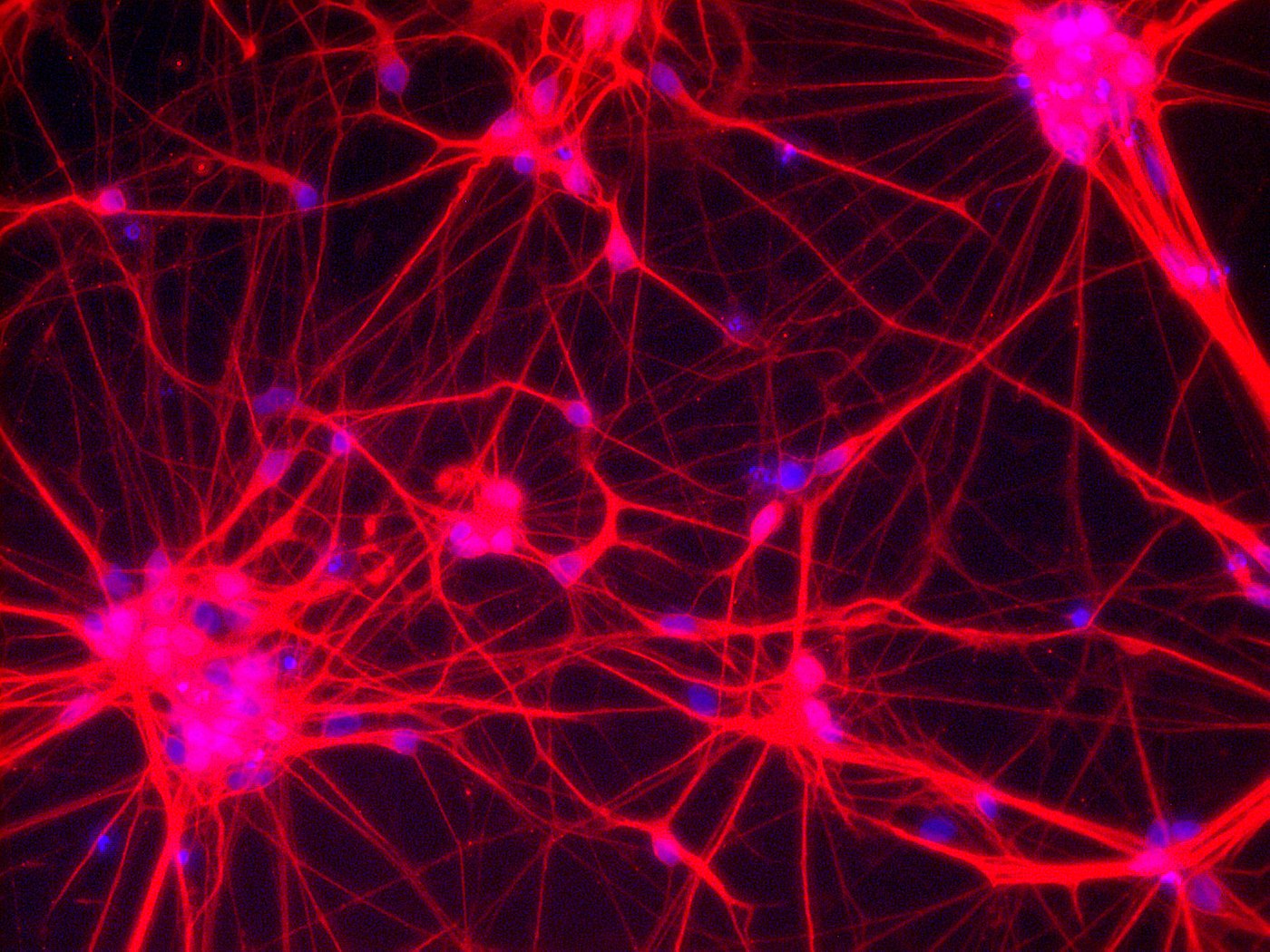
Neurons – Network of neuronal cells (Blue: nucleus; Red: neurons) [Copyright: Institute for Transfusion Medicine, UK Essen]
There is much that researchers do not yet know about the early development of human embryos. Recently, scientists have been increasingly successful in creating embryo-like structures using stem cells. Important new insights could be gained from these ‘embryo models’, but legal and ethical questions must also be clarified.
Insights into embryonic development using synthetic embryos
The first days and weeks of embryo development are particularly important for the course of a pregnancy. However, researching this phase is not easy, especially with human embryos. Observations with ultrasound are possible only from around the fifth week of pregnancy. Early embryos created by fusion of egg and sperm outside the mother's body via in vitro fertilization are usually transferred to the uterus after six or seven days at the latest. Keeping human embryos alive in the laboratory beyond this period seems increasingly possible, but a widely accepted rule only allows this up to the 14th day after fertilization (or until the appearance of the so-called primitive streak). There are thus practical as well as moral and legal boundaries to research on embryonic development in humans.
In recent years, scientists have discovered that, under certain conditions, stem cells can develop into cell clusters that resemble early embryos. Since these structures are not, like natural embryos, created by the fertilization of an egg cell, they are referred to as embryoid bodies or synthetic embryos. For example, researchers have been able to create so-called embryo models from mouse stem cells that resemble early mouse embryos between 3.5 and 8.5 days after fertilization. Some models include cell structures similar to those of the embryo itself and the surrounding tissue (from which, for example, the placenta develops). Other models include only structures that appear to correspond to parts of a natural embryo. The development of artificial embryos from human cells is less advanced: So far, only specific features of embryonic development, such as aspects of gastrulation (formation of the germ layers from the blastula) or of the development of the amniotic cavity have been modelled. However, it is foreseeable that methods will improve and that creating embryo models increasingly like natural embryos will become feasible. This makes the question of which rules should apply to research on synthetic embryos increasingly urgent. The answer depends, however, not only on how similar artificial embryos are to natural embryos, but also on the benefits research on them might have.
Future-proof rules for promising research
Progress in the creation of synthetic embryos could deepen our understanding of the development of natural embryos. In the long term, this could enable the development of new treatments for infertility or better methods of contraception. Genome-edited embryo models could bring insights into the genetics of malformations during embryonic development. Our knowledge about stem cells could also be advanced by studying the models. Since stem cells can be reproduced in the laboratory, synthetic embryos could be generated in large numbers, which would be helpful for testing drugs. In addition, different models could be used to study specific phases of embryonic development.
In order to enable the pursuit of these promising aims, it is important that research on embryo models is clearly regulated. The legal and moral status of the various types of embryo models already available and of those conceivable in the future is still unresolved - researchers, but also research funders, thus do not always find unambiguous information on whether a particular project is permissible. Scientists are therefore calling for a broad social debate, based on which detailed rules for the handling of artificial embryos should be developed. A crucial question arises naturally: Should a cell structure that is very similar to a natural embryo enjoy similar protection? Future regulation should determine, for example, whether and in which cases embryo models must be treated like embryos, since the various model types differ significantly in possibly morally relevant characteristics such as their developmental potential. It should also be specified for which purposes research on embryo models may be conducted – limited, perhaps, to high-ranking goals such as the treatment of serious diseases. The creation of human beings from artificial embryos is rejected as legitimate research purpose by numerous professional bodies, including the International Society for Stem Cell Research (ISSCR).
It is important that the debate is conducted with the participation of experts from the natural sciences, but also lawyers, philosophers, representatives of patient associations and religious groups, physicians, politicians and other stakeholders, so that the resulting rules reflect a broad consensus. An important impetus for this process will be provided by an update on embryo model research to the ISSCR's "Guidelines for Stem Cell Research and Clinical Translation", which is currently being prepared by a group of experts and due to be published in spring 2021.
Press coverage and expert statements:
Scientific publications: